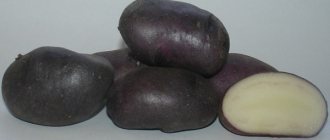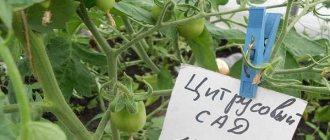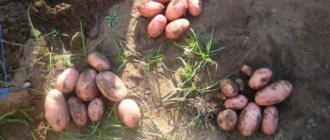The history of the origin of the potato variety “Sonny”
“Sonny” was bred by amateur gardeners. Although this variety is not included in the State Register, it is still popular among local summer residents.
“Sonny” can be grown in any climatic conditions. It tolerates temperature changes, short-term cold snaps, and short-term droughts well.
The table below presents data on the yield of other potato varieties:
| Name | Variety | Productivity |
| Nikulinsky | Late ripening | From 170 to 300 centners per hectare. |
| Cardinal | Late ripening | From 200 to 350 centners of potatoes are harvested from 1 hectare. |
| Rocco | Late ripening | From 350 to 400 centners per hectare. |
| Kiwi | Late ripening | From 1 kg of planting tubers it reaches 20 kg. |
| Picasso | Late ripening | From 1 hectare about 20 tons. |
| Borovichok | Early ripening | 200-250 centners per 1 hectare of land. |
| Elmundo | Early ripening | 250-350 centners per hectare. |
| Felox | Early ripening | 250 centners per hectare. |
| Bellarosa | Early ripening | The harvest from one bush is 8-10 tubers. |
| Natasha | Early ripening | From 130 to 190 centners per hectare. |
| Forty days | Extra early | Up to 300 centners of potatoes are harvested from one hectare of soil. |
| Karatop | Extra early | From 18.5 to 27 tons per hectare (Middle Volga region), from 20 to 43.5 tons per hectare (Northwestern region). The maximum yield is 50 tons per hectare. |
| Riviera | Extra early | After the first digging on the 45th day after the emergence of potato shoots, it ranges from 134 to 225 centners per hectare. The maximum yield by the end of the growing season reaches 450 centners per hectare. |
| Zhukovsky early | Extra early | The harvest from one bush is up to 15 tubers. |
| Minerva | Extra early | Fertile soils allow you to harvest the first harvest of up to 230 centners per hectare. By the end of the growing season (45-50 days), the maximum yield is achieved - up to 430 centners per hectare. |
| Crane | Mid-late | 640 centners per hectare. |
| Sorcerer | Mid-late | Productivity varies from 27 to 35 tons per hectare. |
| Mozart | Mid-late | The average yield is approximately 430 c/ha. |
| Grenada | Mid-late | From one hectare you can harvest up to 60 tons of potatoes. |
| Ramona | Mid-late | The yield is consistently average from 10 to 15 tons per hectare. |
| Yanka | Mid-early | The average yield ranges from 195 to 315 centners per hectare. |
| Giant | Mid-early | The average harvest ranges from 290 to 424 centners per hectare. |
| Tuscany | Mid-early | Productivity varies from 210 to 400 centners per hectare. |
| Purple Haze | Mid-early | Productivity varies from 182 to 309 centners per hectare. |
| Santana | Mid-early | The average yield varies from 164 to 384 centners per hectare. |
Features of planting and growing
Growing the variety does not require any special skills. To get a good harvest, follow the planting pattern and minimal care.
Pre-sowing preparation
Seed material is prepared in the fall. Select healthy medium-sized tubers. Three weeks before planting, they are taken out of storage and taken to a bright place for germination. During this time, the potatoes will turn green and sprout.
The place chosen is sunny and open, where the predecessors grew legumes, rye, alfalfa, corn or flax.
Soil requirements
The soil is dug up in the fall, adding humus (10 kg is enough for 1 sq. m), superphosphate (25 g) and wood ash. Sonny (Bogatyr) is undemanding about the composition of the soil, but he does not like too acidic soil. Therefore, when there is increased acidity, lime is scattered over the surface of the earth.
Dates, scheme and rules of planting
Planting dates in regions with warm climates are mid-April or early May. In the regions of the Urals, Siberia, and Central Black Earth Region - from mid to late May.
A distinctive feature of the variety is the possibility of its frequent planting. 70 cm is maintained between rows, and 35 cm between tubers in a row. Thickened planting will not in any way spoil the yield indicators. The variety even benefits from this scheme: the shade from the closing tops retains moisture, reduces the growth of weeds and saves area.
Bogatyr is planted in holes 10 cm deep or in long grooves, where wood ash is added.
Features of cultivation
Immediately after planting, Bogatyr is not watered or fed. The potatoes themselves will take spring moisture from the soil and nutrition from fertilizers applied in the fall. This will be enough until flowering begins.
Watering mode
In the middle zone, natural precipitation is sufficient for normal crop formation. During drought, abundant single watering is recommended. For the Sonny variety, the best time for additional moisture is the flowering period, when tubers are laid. In hotter climates, watering is carried out no more than once every 15 days.
Top dressing
Another advantage of the variety is that it does not require fertilizing if fertilizers were applied in the fall. But if the soil is heavy, dense and not pre-fed, phosphorus and potassium fertilizers are applied during flowering and budding.
Weeding and hilling
Weed control is an important part of potato care. They are removed as they appear and are not allowed to take nutrients from the soil.
Hilling up bushes is an opportunity to saturate the roots with oxygen and accelerate plant growth.
The procedure is carried out twice:
- when the seedlings reach a height of 10-15 cm;
- two weeks after the first hilling.
Disease and pest control
The variety has proven itself to be disease resistant. The only ailment that affects Bogatyr is late blight, which occurs in the autumn, in damp and cool weather.
Dark spots appear on the affected potato bush, which then spread to the stems. The greens turn brown, the tubers rot.
Late blight can be defeated with the help of the biological preparation “Fitosporin”. Spraying is carried out at the stage of flower appearance and budding. They also use a folk remedy - an infusion of garlic with manganese (100 g of crushed garlic per 10 liters of water with the addition of 1 g of potassium permanganate).
Pest varieties:
- The Colorado potato beetle is a dangerous insect for potatoes. If the planting area is small, get rid of insects by collecting them by hand. Or they use insecticides for spraying - chemicals that kill insects.
- Wireworm is a worm that penetrates a tuber. Appears in potatoes at any stage of plant development. It eats roots, stems and young shoots, moves inside root crops, and gnaws out tunnels. To protect yourself from wireworms, carefully remove any remaining tops after digging up potatoes. in the fall, dig up the soil, plant repellent plants next to the potatoes. To protect yourself from wireworms, carefully remove the remains of the tops after digging up the potatoes, dig up the soil in the fall, and plant repellent plants next to the potatoes: marigolds and calendula. marigolds and calendula.
- Mole cricket is a pest that destroys roots and tubers. To combat insects, when planting potatoes, pour finely crushed eggshells into the holes.
There are no particular difficulties when growing the variety.
Problems arise if:
- plant potatoes in the same place for several years in a row (the variety accumulates infections, yields are reduced);
- plant potatoes in cold soil;
- do not fight pests and diseases.
Advantages and disadvantages
Among the positive qualities are:
- High yield;
- The versatility of the root crop;
- Excellent taste;
- Resistance to cold, drought, heat;
- Easy to care for;
- Good keeping quality;
- Resistance to major potato diseases.
They also note resistance to mechanical damage.
Potatoes and new varieties are being studied in Belarus:
Harvest and storage
It is recommended to collect Varyag potatoes in warm and dry weather. 14 days before digging up the potato variety, vegetable growers advise mowing the tops and stopping watering procedures.
After harvesting, the potatoes are carefully inspected and fruits unsuitable for storage are removed: cut or rotten potatoes must be removed.
It is recommended to store the root vegetable in cool rooms with temperatures up to 4 degrees Celsius. As a rule, basements, such as a cellar, are chosen for storage. Vegetable growers also note that it is not recommended to store Varyag potatoes in dense containers, since oxygen does not reach the fruits of the variety, which leads to their rotting.
Reviews about the variety
Farmers love the Sonnok potato for its unpretentiousness, high yield and excellent taste. It can be sold, but most often they grow the root crop for their own needs.
We invite you to familiarize yourself with potato varieties that have different ripening periods:
| Late ripening | Early ripening | Very early | Mid-late | Mid-early |
| Nikulinsky | Borovichok | Forty days | Crane | Yanka |
| Cardinal | Elmundo | Karatop | Sorcerer | Giant |
| Rocco | Felox | Riviera | Mozart | Tuscany |
| Kiwi | Bellarosa | Zhukovsky early | Grenada | Purple Haze |
| Ivan da Marya | Natasha | Farmer | Melody | Openwork |
| Picasso | Ariel | Minerva | Margarita | Santana |
| Asterix | Queen Anne | Veneta | Ramona | Desiree |
| Slav | Arosa | Kiranda | Dolphin | Lady Claire |
Diseases and pests: how to fight
Caring for Bogatyr is simple because it is resistant to diseases such as:
- Alternaria blight;
- scab;
- potato cancer;
- blackleg.
The plant can become ill with late blight; universal products containing copper will help cope with the problem. Pests can appear when the plant’s immunity is weak, this is only if there is no care for the bushes at all. In this case, they are treated with special insecticides, which are sold in stores in an assortment.
This Sonny/Bogatyr potato is very controversial and controversial. There are many companies that claim that they developed this variety, but it appeared quite a long time ago. There is no reliable information about its origin, and summer residents understand shortcomings that are not immediately noticeable only later. But the variety is worthy of attention, as well as growing on a personal plot.
Plant care
Caring for planted seedlings is no different from cultivating potatoes planted in the traditional way: loosening, hilling, pest control. The only difference is a more attentive attitude to watering (it is necessary to water during dry periods) and fertilizing. During the growing season, it is necessary to apply fertilizer three times: they are diluted in 10 liters of water and added 0.5 liters for each bush:
- During the growth of tops: 1 tbsp. l. urea or 0.5 liters of mushy mullein.
- During budding: 2 tbsp. l. potassium sulfate or 1 cup of wood ash.
- During flowering: 2 tbsp. l. superphosphate and 1 liter of nitrophoska.
Potato propagation by seeds
It’s good when you have the opportunity to purchase tubers of your favorite potato variety at an affordable price, or you have leftover potatoes for planting from last year’s harvest grown in your garden. What if it’s expensive to buy, but you don’t have enough tubers of your own? In this case, vegetable growers can grow potatoes using seeds, collecting them from their plot or buying them in a store. The method of planting potatoes by seeds is also used if yields begin to fall (potatoes “degenerate”).
One of the biological features of potatoes grown from seeds will be heterogeneity in early maturity, shape and color of tubers, and resistance to diseases.
Table: advantages and disadvantages of planting potatoes with seeds
| Advantages | Flaws |
| The price of seeds is lower than that of planting tubers. | Labor-intensive and painstaking work. |
| Long (up to 10 years) shelf life. | This method is not suitable in short summer conditions |
| The yield is 15–25% higher than when grown in the traditional way. | A full harvest is usually obtained in the second year. |
| Potatoes are more resistant to diseases and environmental influences. | Weak and fragile shoots. |
| Possibility of breeding work in your own garden. | When grown from seeds collected from your own garden, the varietal characteristics of the mother variety are not preserved. |
Growing seedlings
Work on growing potato seedlings begins in late March or early April:
- The seeds are soaked for 2–3 days in damp gauze, a cloth or paper. To increase germination, it is recommended to treat the seeds with solutions of microelements and biostimulants (for example, Epin or Zircon).
- Over the course of 10–15 days, the seeds are hardened by changing temperatures: at night they are placed in a refrigerator with a temperature no higher than +1°C, and in the room during the day.
- Germinate the seeds in a damp cotton wool or napkin, placing them in a warm place, for example, on a radiator. After two weeks, sprouts appear from the seeds.
- Sprouted seeds are placed in containers with a nutrient mixture. It is prepared from garden soil and peat in a ratio of 1:4. You can use a ready-made mixture for seedlings from the store.
- Seeds are planted in grooves to a depth of 0.5–1 cm according to the following pattern: 25 cm from each other and 10 cm between grooves. About 90–100 seeds are sown in one 60x50 cm container.
- The crops are covered with a 0.5 cm layer of sand, slightly compacting it to avoid being washed away when watering.
- Regularly and very carefully loosen and water - potato sprouts are very fragile. The temperature in the room where seedlings are grown is maintained at least 15–17°C.
Potato sprouts require care when weeding and watering
- 25–30 days after sowing, when the seedlings grow to a height of 7–10 cm, they are planted in plastic cups or peat pots with holes for drainage, deepened to the cotyledon leaves.
- After picking, for better rooting, it is useful to feed the plants with ammonium nitrate (10 g per 10 liters of water) and water generously with warm water. When growing seedlings, it is necessary to maintain a constant temperature (not lower than +15°C during the day and +10°C at night) and lighting.
- After 35–40 days, the seedlings will grow to 15–20 cm and can be planted in the ground.
Seedlings are ready for planting in the ground 40 days after planting the seeds
Planting seedlings in open ground
After the end of frost (usually around the twentieth of May), the seedlings are planted on the site. Dig holes 10–15 cm deep, put 300–400 g of humus in them and water them (0.5 liters of water per hole). Seedlings are planted at a depth so that 2–3 leaves remain above the ground.
To obtain seed tubers, plants are planted at a distance of 10–20 cm in a row. Then from each bush you can get a lot of small potatoes, which will be excellent planting material for next year. To grow potatoes for consumption, a distance of 40 cm is left between plants - in this case, large tubers ripen, but their number decreases. In both cases, there should be 60–70 cm between rows.
Video: growing potatoes from seeds
Description and characteristics of the variety
Bogatyrsky potatoes are included in the line of late-ripening varieties intended for table use. The growing season until full ripening lasts 120-140 days. During this period, 1 plant grows to 25-40 tubers, the entire crop is approximately the same size and weight - 70-90 g each. There are practically no small root crops.
The bushes are of medium height - within 45-55 cm, the stems are strong, they fall over only after withering (at the time of harvesting). The shoots are erect. The leaves are small, slightly wrinkled, and the color is rich green. The buds are white and large. Flowering does not last long, berries are rare.
What are the distinctive features of tubers:
- average weight 70-80 g;
- maximum weight reaches 150 g;
- round shape, slightly elongated;
- tops rounded;
- starch level 13-14%;
- the peel is strong, pinkish-cream;
- the eyes lie 1-2 mm apart;
- a light mesh is visible on the shell;
- The pulp is dense in texture and light in color.
The taste of the variety is excellent. The tubers accumulate enough sugars and dry components.
Preparing to plant potatoes
The “Sonny” potato variety, a description and photo of which is available online on various forums and websites, is considered unpretentious to light, but it is better to choose the sunniest corner for placing it.
It would also be a good idea to have a fence around the area with potatoes to protect it from strong winds. The site should also be located on a hill, since nearby groundwater will negatively affect its development. Even during harvesting, it is necessary to immediately separate good medium-sized tubers, which will be used as seed material for the next year. They must be of the correct shape, without damage or disease. They are kept in the sun for several days until they turn green, and then put away for storage. The selected tubers are stored separately from the rest and a month before planting, they are removed from the cellar and laid out in one layer in a lighted place for germination. After a couple of weeks, you can stimulate the development of sprouts by spraying with special chemical compounds or a mixture of superphosphate and potassium nitrate.
To increase resistance to infections, tubers are treated with a steep solution of manganese, copper sulfate or Bordeaux mixture.










